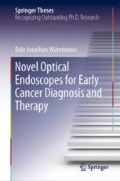Abstract
The pituitary gland is a pea-sized organ situated behind the ridge of the nose, attached to the base of the brain by a thin stalk. It is a key component of the endocrine system, responsible for hormonal control of other glands as well as many aspects of normal functioning including growth and blood pressure. The most common disease associated with the pituitary gland is pituitary adenoma, the development of a benign tumour. During surgical resection of pituitary adenoma, a delicate balance must be struck between maximising completeness of tumour resection and preserving endocrine function by conserving the normal pituitary. Currently, resection is guided by white light imaging, but it is often difficult to delineate the normal pituitary gland and the adenoma. This Chapter reviews the current standard of care for intraoperative imaging of pituitary adenoma and describes the development of a multispectral endoscope designed to address the clinical need for improved visualisation during resection.
Access this chapter
Tax calculation will be finalised at checkout
Purchases are for personal use only
References
Ezzat S et al (2004) The prevalence of pituitary adenomas: a systematic review. Cancer 101:613–619
Theodros D, Patel M, Ruzevick J, Lim M, Bettegowda C (2015) Pituitary adenomas: historical perspective, surgical management and future directions. CNS Oncol 4:411–429
Kuo JS et al (2016) Congress of neurological surgeons systematic review and evidence-based guideline on surgical techniques and technologies for the management of patients with nonfunctioning pituitary adenomas. Neurosurgery 79:E536–E538
Hazer DB et al (2013) Treatment of acromegaly by endoscopic transsphenoidal surgery: surgical experience in 214 cases and cure rates according to current consensus criteria. J Neurosurg 119:1467–1477
Acebes JJ, Martino J, Masuet C, Montanya E, Soler J (2007) Early post-operative ACTH and cortisol as predictors of remission in cushing’s disease. Acta Neurochir 149:471–477
Bao X et al (2016) Extended transsphenoidal approach for pituitary adenomas invading the cavernous sinus using multiple complementary techniques. Pituitary 19:1–10
Berkmann S, Schlaffer S, Buchfelder M (2013) Tumor shrinkage after transsphenoidal surgery for nonfunctioning pituitary adenoma. J Neurosurg 119:1447–1452
Esquenazi Y et al (2017) Endoscopic endonasal versus microscopic transsphenoidal surgery for recurrent and/or residual pituitary adenomas. World Neurosurg 101:186–195
Verstegen MJT et al (2016) Intraoperative identification of a normal pituitary gland and an adenoma using near-infrared fluorescence imaging and low-dose indocyanine green. Oper Neurosurg 12:260–267
Buchfelder M, Schlaffer SM (2012) Intraoperative magnetic resonance imaging during surgery for pituitary adenomas: pros and cons. Endocrine 42:483–495
Akutsu N, Taniguchi M, Kohmura E (2016) Visualization of the normal pituitary gland during the endoscopic endonasal removal of pituitary adenoma by narrow band imaging. Acta Neurochir 158:1977–1981
Rigante M et al (2017) Preliminary experience with 4K ultra-high definition endoscope: analysis of pros and cons in skull base surgery. Acta Otorhinolaryngol Ital 237–241
Sandow N, Klene W, Elbelt U, Strasburger CJ, Vajkoczy P (2015) Intraoperative indocyanine green videoangiography for identification of pituitary adenomas using a microscopic transsphenoidal approach. Pituitary 18:613–620
Litvack ZN, Zada G, Laws ER (2012) Indocyanine green fluorescence endoscopy for visual differentiation of pituitary tumor from surrounding structures. J Neurosurg 116:935–941
Lee JYK et al (2017) Folate receptor overexpression can be visualized in real time during pituitary adenoma endoscopic transsphenoidal surgery with near-infrared imaging. J Neurosurg 1–14
Yamada S, Takada K (2003) Angiogenesis in pituitary adenomas. Microsc Res Tech 60:236–243
Jugenburg M, Kovacs K, Stefaneanu L, Scheithauer BW (1995) Vasculature in nontumorous hypophyses, pituitary adenomas, and carcinomas: a quantitative morphologic study. Endocr Pathol 6:115–124
Hide T, Yano S, Shinojima N, Kuratsu J (2015) Usefulness of the indocyanine green fluorescence endoscope in endonasal transsphenoidal surgery. J Neurosurg 122:1185–1192
Highlights | KARL STORZ endoskope | United Kingdom. Available at https://www.karlstorz.com/gb/en/highlights-tp.htm. Accessed on 14 Sept 2018
van Dam GM et al (2011) Intraoperative tumor-specific fluorescence imaging in ovarian cancer by folate receptor-α targeting: first in-human results. Nat Med 17:1315–1319
Hoogstins CES et al (2016) A novel tumor-specific agent for intraoperative near-infrared fluorescence imaging: a translational study in healthy volunteers and patients with ovarian cancer. Clin Cancer Res 22:2929–2938
Evans C et al (2003) Differential expression of folate receptor in pituitary adenomas. Cancer Res 4218–4224
Larysz D et al (2012) Expression of genes FOLR1, BAG1 and LAPTM4B in functioning and non-functioning pituitary adenomas. Folia Neuropathol 50:277–286
Evans C, Yao C, LaBorde D, Oyesiku NM (2008) Chapter 8 folate receptor expression in pituitary adenomas: cellular and molecular analysis. Vitam Horm 79: 235–266
Lu G, Fei B (2014) Medical hyperspectral imaging: a review. J Biomed Opt 19:10901
Calin MA, Parasca SV, Savastru D, Manea D (2014) Hyperspectral imaging in the medical field: present and future. Appl Spectrosc Rev 49:435–447
Joshi BP et al (2016) Multimodal endoscope can quantify wide-field fluorescence detection of Barrett’s neoplasia. Endoscopy 48
Yang C, Hou V, Nelson LY, Seibel EJ (2013) Color-matched and fluorescence-labeled esophagus phantom and its applications. J Biomed Opt 18:26020
Valdés PA et al (2012) Quantitative, spectrally-resolved intraoperative fluorescence imaging. Sci Rep 2:798
Pelli DG, Bex P (2013) Measuring contrast sensitivity. Vision Res 90:10–14
Author information
Authors and Affiliations
Corresponding author
Rights and permissions
Copyright information
© 2019 Springer Nature Switzerland AG
About this chapter
Cite this chapter
Waterhouse, D.J. (2019). Rigid Endoscopy for Intraoperative Imaging of Pituitary Adenoma. In: Novel Optical Endoscopes for Early Cancer Diagnosis and Therapy. Springer Theses. Springer, Cham. https://doi.org/10.1007/978-3-030-21481-4_6
Download citation
DOI: https://doi.org/10.1007/978-3-030-21481-4_6
Published:
Publisher Name: Springer, Cham
Print ISBN: 978-3-030-21480-7
Online ISBN: 978-3-030-21481-4
eBook Packages: Physics and AstronomyPhysics and Astronomy (R0)

